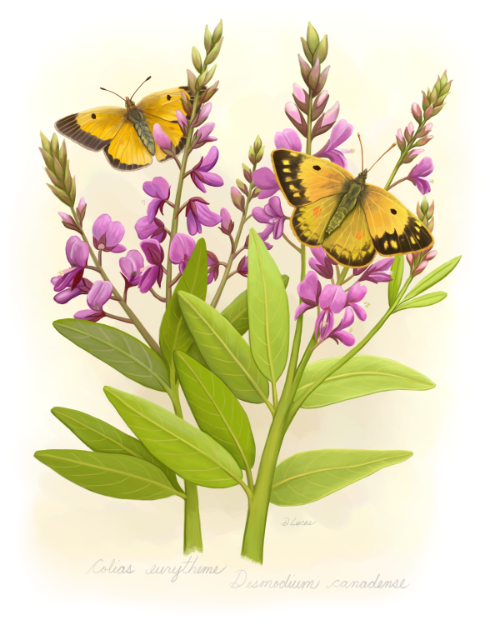Orange Sulphur / Colias eurytheme
Wingspan: 3.5 – 6 cm (1.4 – 2.4 in)
Sulphur butterflies belong to the Pieridae family. They are named after the non-metallic element, sulphur because many of these butterflies are bright yellow. These butterflies can also be orange or white. Sulphur butterflies are small to medium in size and are swift, erratic flyers.
The Orange Sulphur butterfly is found throughout North America, from southern Canada and the Maritime provinces (excluding Labrador), to central Mexico.
You can attract this small butterfly to your garden by having the host and nectar plants it needs for its survival. Butterfly larvae (caterpillars) require specific host plants to sustain themselves and grow to the chrysalis stage. The Orange Sulphur butterfly is fortunate to have the entire pea and legume family of plants (Fabaceae), for host plants. The Fabaceae family is the third-largest family of flowering plants consisting of 20,000 species.
Caterpillar Host Plants
Some of the Orange Sulphur host plant species are – Tick Trefoil (Desmodium canadense), clover (Trifolium spp.), alfalfa (Medicago sativa), White Clover (Trifolium repens), White Sweet Clover (Melilotus alba), vetches (Vicia, sp.), wild Indigoes (Baptisia spp.), Wild Senna (Senna marilandica and S. hebecarpa), Self-heal (Prunella vulgaris), and Wild Lupine (Lupinus perennis).
The Orange Sulphur Caterpillar
Orange Sulphur caterpillars are green with a yellowish-white stripe on the side. The caterpillars usually eat at night.
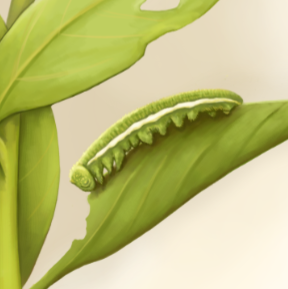
In farmland mono-cultures Sulphur butterflies are often considered pests and their numbers can get out of control. In meadows and gardens, however, they are an important part of the ecosystem. Sulphur butterflies are pollinators and part of the food web. Caterpillars are very important food for songbird nestlings.
The Orange Sulphur Chrysalis
When the caterpillar is in its 4th or 5th instar (stage of growth) it will crawl to a sheltered place and secure itself to a plant or surface to transform into a chrysalis. If the summer is over, the Orange Sulphur will remain as a chrysalis for the winter.
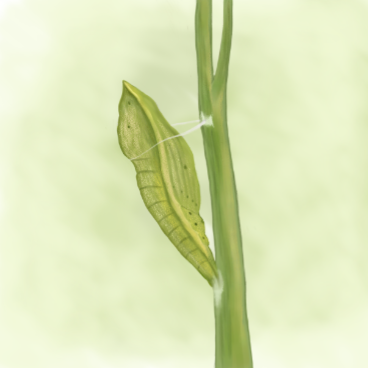
The Adult Orange Sulphur Butterfly
Orange Sulphur’s wings are yellowish-orange. The female is occasionally white; her wings have a brown-black border with yellow spots. The male Orange Sulphur has solid dark borders on its wings. The orange on his upper wing reflects ultraviolet light. The reflecting ultraviolet light helps the female distinguish the Orange Sulphur male from a similar species, the Clouded Sulphur.
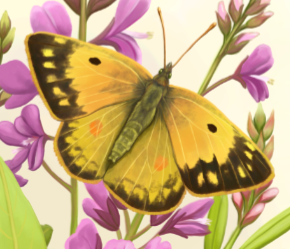
Adult Diet/Nectar Plants
Orange Sulphurs nectar at a variety of flowers. These include milkweed (Asclepias spp.), black-eyed Susans (Rudbeckia spp.), Purple Coneflower (Echinacea purpurea), fleabanes (Erigeron spp.), asters (Symphpyotrichum spp.), goldenrods (Solidago spp.), and more.
Orange Sulphurs have two or three broods and fly from May/June through October/November, so you will need a succession of flowering nectar plants in your garden, from early spring through to fall to provide habitat for these butterflies.
By planting the host and nectar plants that the Orange Sulphur butterfly needs to survive, you may find these pretty orange and yellow butterflies take up residence in your garden.
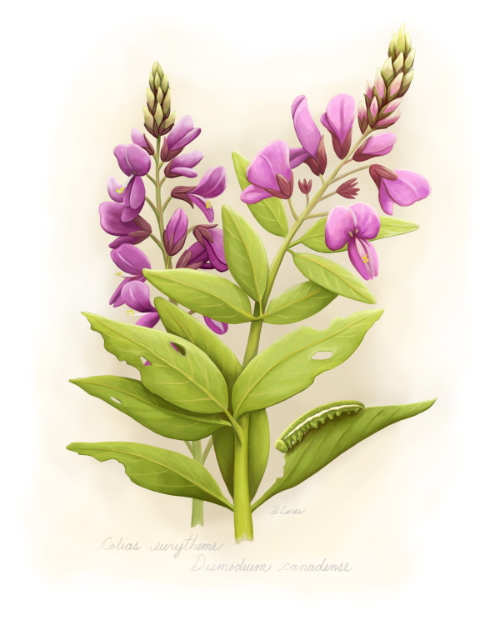
A Butterfly Garden – is a pollinator/wildlife garden. Never use herbicides or pesticides anywhere near a butterfly garden.
Look but do not Touch – please do not buy butterfly kits or chrysalis’ from commercial breeders or home rear butterflies. This is cruel to the animals, can create unfit populations and spread diseases to the wild species.
Links to find out more about plants native to your area:
Canadian Wildlife Federation – native plant encyclopedia HERE
Ladybird Johnson Wildflower Center HERE
A great native seed house and information source is Prairie Moon Nursery – link to it HERE
*Please subscribe to this blog for more posts on butterflies and native gardening.

